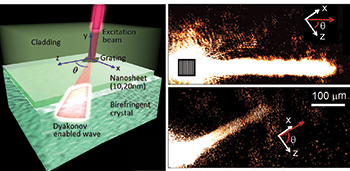 Direct observation of GEDS. (Left) A nanosheet geometry composed of a cladding with a transparent nanosheet and a biaxial birefringent crystal. (Right) GEDS steering by changing the refractive index of the material forming the cladding.
Direct observation of GEDS. (Left) A nanosheet geometry composed of a cladding with a transparent nanosheet and a biaxial birefringent crystal. (Right) GEDS steering by changing the refractive index of the material forming the cladding.
Surface waves are a topic of continually renewed interest due to their unique properties and prospects of important applications in different areas of science and technology. They could be powerful tools for interrogating the properties of material interfaces, hence their physical, chemical and biological composition. But surface waves are rare, as they are supported only in specific materials and configurations.
A unique type of surface wave that exists at the interface of anisotropic crystals was predicted by Dyakonov in 1988 and observed for the first time a few years ago.1,2 The excitation conditions of Dyakonov surface states are difficult to meet in practice. However, their very existence affords the possibility of generating new modes in structures incorporating a nanosheet film whereby light can be guided in a robust way for any thin film, even down to a few nanometers. As a result, new guided modes enabled by Dyakonov surface waves (GEDS) exist well below the standard waveguide cutoff. GEDS exist at the surface of transparent materials, thus they can propagate without losses, and they exhibit a localization degree similar to that of long-range plasmons. In addition, structures that incorporate nanosheets relax the conditions required for the existence of pure surface states, and the localization degree of the modes can be controlled by varying the properties of the nanosheet.
We recently demonstrated such a scheme in a specially designed configuration based on a lithium triborate biaxial crystal with 10 and 20 nm of alumina nanosheets and suitable index-matching cladding liquids.3 We directly observed the propagation of light guided by the nanosheets by capturing the scattered light out of the modes. Furthermore, we observed how the direction of light propagation can be controlled by modulating the refractive index of the liquid forming the cladding. This allowed us to demonstrate the controllable steering of the surface waves using the intrinsic high-directionality of Dyakonov waves. Our experiment is a proof-of-principle demonstration, but it must be emphasized that the scheme can be implemented in different, suitably engineered metamaterial structures with form anisotropy that support Dyakonov-like waves.4
The demonstration of GEDS supported by nanosheets opens up new fascinating avenues in the effort to implement photonic devices based on guided surface waves. Those include routing and sensing applications based on the sensitivity of surface waves to the extrinsic surface properties and, by and large, all applications that may benefit from the possibility of lossless, tunable highly directional propagation of light attached to a surface, such as in planar photonic metasurface schemes.5
Researchers
Osamu Takayama, David Artigas and Lluis Torner, Institut de Ciencies Fotoniques and Universitat Politecnica de Catalunya, Barcelona, Spain
References
1. M.I. Dyakonov. Sov. Phys. JETP 67, 714 (1988).
2. O. Takayama et al. Phys. Rev. Lett. 102, 043903 (2009).
3. O. Takayama et al. Nat. Nanotech. 9, 419 (2014).
4. H.N.S. Krishnamoorthy et al. Science 336, 205 (2012).
5. A.V. Kildishev et al. Science 339, 1232009 (2013).
